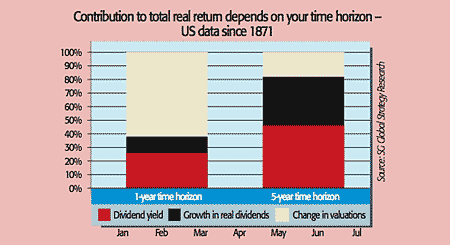
“Do you know the only thing that gives me pleasure? It’s to see my dividends coming in,” said oil tycoon John D. Rockefeller. You might conclude that he should have broadened his interests a bit. But there’s an important lesson to be learned from the fixation of the world’s richest-ever man.
Dividends drive returns on stocks
Over the long-term, dividends are the key driver of returns on stocks. Since 1900, the S&P 500 has returned an average of around 6% a year in real (inflation-adjusted) terms, according to Capital Economics. But most of that was down to reinvesting dividends. Capital gains on the original investment account for just 1.5% a year. The longer you hold your shares, the more important dividends become. Over one year, around 60% of an investor’s real return comes from changes in the stock price, says James Montier of Société Générale. But over five years, the combination of the initial dividend yield and the growth in dividends accounts for 80% of returns. In short, unless you’re a trader, dividends matter a lot.
That makes perfect sense once you remember what a share is: it’s a claim on the assets and future cash flows of a company. So while share prices in the short term can be driven by a host of factors – from excitement over a new, hot technology to fear of an impending apocalypse – long-term, they must be driven by how much hard cash the company returns to shareholders.
The initial yield is vital
In modern markets, the initial yield has been very important, says Montier’s colleague Andrew Lapthorne. From 1970 to the present, dividend growth beat inflation by an average of just 1.2 percentage points across the five biggest equity markets (France, Germany, Japan, Britain and America). The bulk (70%) of real returns from dividends came from the initial yield. On this evidence, investors will get the best returns by investing when dividend yields are high, rather than by betting on growth. Lapthorne also shows that this applies at the individual stock level: total returns from those with above-average dividend yields outperform those with below-average yields. In other words, history suggests you get better returns from investing in stocks that are already good yielders than from hoping that stocks that aren’t will grow their yield substantially.
The good news for investors is that there are plenty of high-yielding stocks around at present. The yield on the S&P 500 is back to levels not seen for 20 years at 3.5%, the FTSE yields 5.3%, and even perennially low-dividend Japan is now paying 3% on the Topix benchmark. But, of course, there’s a snag: how sustainable are those dividends? There’s no doubt that in a deep recession dividends will be cut hard. That said, because a dividend cut is badly received by investors, firms try to avoid it if possible. During the Great Depression, US dividends fell by 47% peak-to-trough in real terms, according to data compiled by Irrational Exuberance author Robert Shiller. However, earnings fell by 67% and the S&P composite index by 81% (both in real terms). So dividends were more persistent than you might have expected. Indeed, the reluctance to cut seems to have been so great that between 1930 and 1933, dividends often exceeded earnings.
But today, many stocks trade at high yields for good reason; their dividends will be annihilated rather than cut and will not be rebounding soon. Recent examples include most of the banking sector and the housebuilders. Avoiding traps as bad as these is really a macroeconomic judgement: if the outlook for the sector is very bleak, then they should be ignored regardless of how tempting the current yield looks. Beyond this, investors can apply a number of criteria to stocks to check the sustainability of their dividends.
So what should you buy now?
Lapthorne tested several factors to see what would have delivered the most upside to a simple above-average yield portfolio over the last 20 years. At the simplest level, selecting stocks with yields between 100% and 120% of the market average delivered good results (since very high-yielding stocks are often distressed). For a more complex screen, Lapthorne found that checking the Piotroski score (a measure of the quality of the firm) and balance-sheet strength (he used a complex test called the Merton model, but the Altman Z score is a simpler alternative) gave the best results. The commonly used earnings cover metric (earnings/dividend) didn’t improve performance.
Stocks that pass his filters include AstraZeneca (LSE:AZN), which yields 5.8%; defence manufacturer Northrop Grumman (NYSE:NOC), yielding 3.9%; publisher Pearson (LSE:PSON), on 4.6%; and France Telecom (FP:FTE), which yields 9.2%.